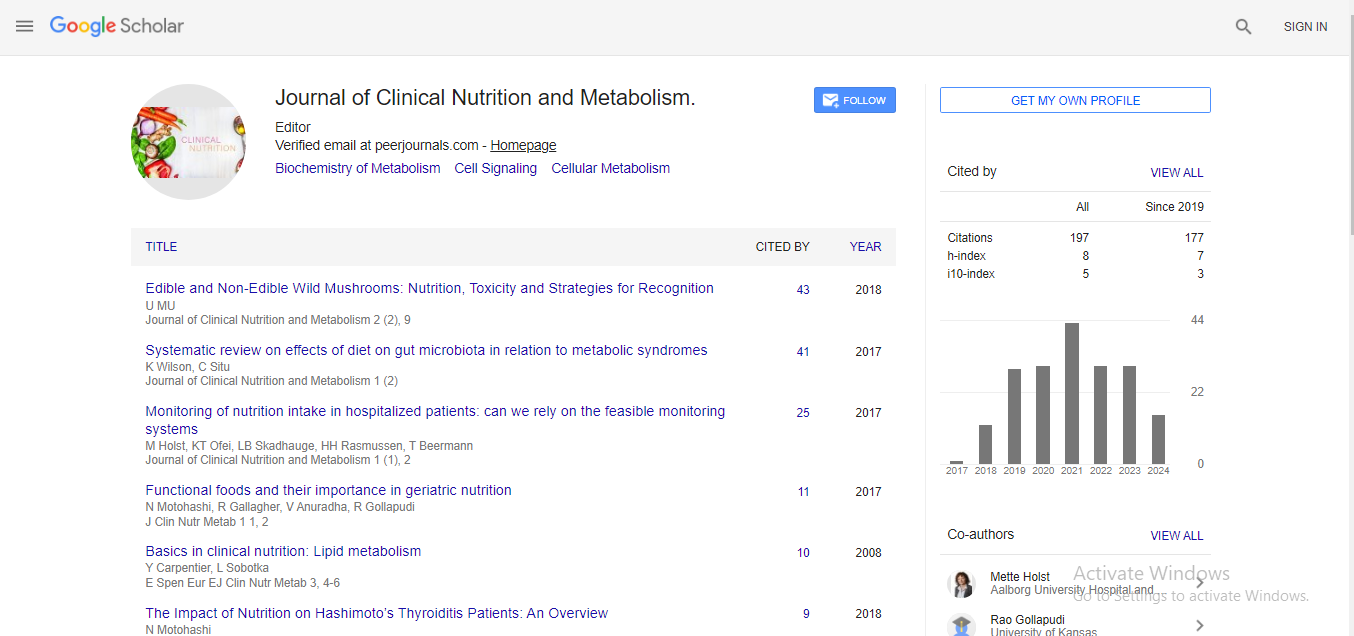Editorial, J Clin Nutr Metab Vol: 5 Issue: 4
Influence of Black Tea Consumption
Lijing Ke*
Department of Food and Nutrition Sciences, Zhejiang Gongshang University,Hangzhou, China
*Corresponding Author:
Lijing Ke
Department of Food and Nutrition Sciences, Zhejiang Gongshang University,Hangzhou, China
E-mail: lijingke@mail.zjgsu.edu.cn
Received Date: June 03, 2021; Accepted Date: July 14, 2021; Published Date: July 21, 2021
Citation: Ke L (2021) Influence of Black Tea Consumption. J Clin Nutr Metab 5:4. e112.
Copyright: © All articles published in Journal of Clinical Nutrition and Metabolism are the property of SciTechnol, and is protected by copyright laws. Copyright © 2021, SciTechnol, All Rights Reserved.
Abstract
Saliva is first off interacted with meals or drink for the duration of ingestion. Alteration of salivary biochemistry through black tea intake is doubtful and seldom mentioned in literature. The modern-day paintings highlighted the on the spot and behind schedule impact of black tea consuming at the alternate of numerous salivary parameters, such as waft charge, ?-amylase and catalase activity, malondialdehyde, thiol, nitric oxide, hydrogen peroxide and overall protein content. Twelve healthful topics elderly among 22 and 31 years vintage have been recruited withinside the study. The saliva changed into gathered before, after and 30 min after black tea intake. The black tea consumption typically prompted an growth of salivary waft charge, overall protein content, catalase, H2O2 and MDA however discount in thiol and nitric oxide for majority of the topics
Keywords: Tea consumption, cardiovascular health, health effects, risks
Saliva is first off interacted with meals or drink for the duration of ingestion. Alteration of salivary biochemistry through black tea intake is doubtful and seldom mentioned in literature. The modernday paintings highlighted the on the spot and behind schedule impact of black tea consuming at the alternate of numerous salivary parameters, such as waft charge, α-amylase and catalase activity, malondialdehyde, thiol, nitric oxide, hydrogen peroxide and overall protein content. Twelve healthful topics elderly among 22 and 31 years vintage have been recruited with inside the study. The saliva changed into gathered before, after and 30 min after black tea intake. The black tea consumption typically prompted an growth of salivary waft charge, overall protein content, catalase, H2 O2 and MDA however discount in thiol and nitric oxide for majority of the topics. Principal factor evaluation confirmed that the salivary waft charge, manufacturing charge of overall protein content, nitric oxide, thiol and malondialdehyde of saliva have been frequently full-size for black tea intake. In Zhengshan Tea Industry, Fujian, China. The dedication of salivary catalase, overall protein content material, hydrogen peroxide, malon-dialdehyde and nitric oxide assay package have been acquired from Beyotime Biotechnology, Shanghai, China. The assay package of salivary α-amylase hobby and thiol content material have been bought from Nanjing Jiancheng Bioengineering Institute, Nanjing, Jiangsu, China.
The bicinchoninic acid (BCA) technique turned into followed for the willpower of overall protein content material in human saliva the usage of bovine serum albumin (BSA) as standard (detection variety 50 – 2000 μg/ml). For the pastime of salivary α-amylase willpower, iodine–starch colorimetric technique turned into used. The α-amylase can hydrolyse starch to produce glucose, maltose and dextrin. According to the manufacturer’s specifications, a blue complicated is shaped with the aid of using the addition of iodine option to the unhydrolyzed starch for a acknowledged awareness of the substrate and it turned into measured the usage of UV–seen Spectrophotometer (Hitachi’s U-5100, Japan). The hydrogen peroxide awareness of saliva turned into decided primarily based totally at the idea of manufacturing Fe3+ions to Fe2+ions oxidized with the aid of using hydrogen peroxide, forming red color with xylene orange in a particular solution. The catalase assay kit (minimal detection level: 1 U/ ml) turned into used to stumble on the catalase pastime of cells, tissues and different samples with the aid of using color reaction.
The catalase pastime which catalyzes hydrogen peroxide to water and oxygen according to unit time and extent is acquired from the usual curve of hydrogen peroxide. The thiol con-tent of saliva become envisioned via the response of thiol compounds with 5,5′-dithiobis- (2-nitrobenzoic) acid (DTNB) to provide a yellowish compound. Lipid peroxidation MDA assay kit becomes implemented for the dedication of malondialdehyde content material in saliva. The reddish MDA- TBA adducts is shaped with the aid of using reacting MDA with thiobarbituric acid (TBA) in excessive temperature and acidic surroundings may be measured via colorimetry on the absorbance of 532 nm. The Griess response become used for the detection of salivary nitric oxide attention. A nitrosating agent is produced with the aid of using acidified NO2– reacts with sulfonic acid to generate the diazonium ion which is then coupled to N-(1-naphthyl) ethyl-enediamine. The formation of chromophoric azo-spinoff is measured with the mild absorption of 540 nm. The absorbance of the determination of general protein content material, hydrogen peroxide, catalase, malondial-dehyde, thiol and nitric oxide attention become measured the usage of Multi- Mode Microplate Reader
 Spanish
Spanish  Chinese
Chinese  Russian
Russian  German
German  French
French  Japanese
Japanese  Portuguese
Portuguese  Hindi
Hindi 